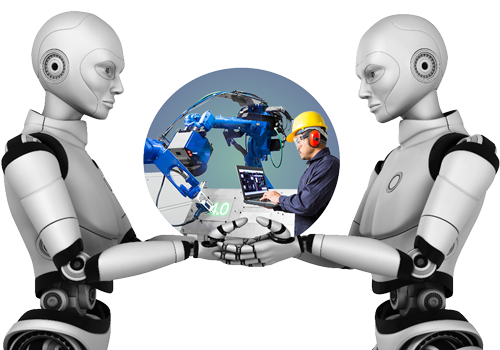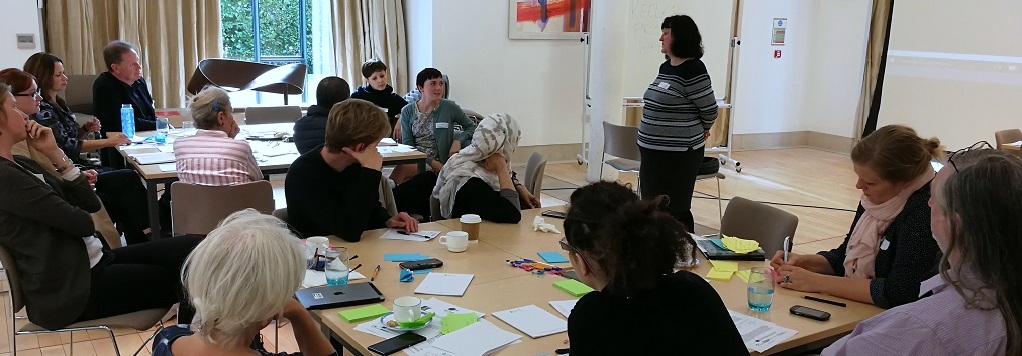Mini-publics
Giving voice!


MINI-PUBLICS: A new method to give citizens a voice
In REELER we have developed our own versions of what is known as ‘mini-publics’ .
Mini-public is a concept originally developed by political scientists. In REELER we have, inspired by this work, developed mini-public into a tool for citizen engagement in the topic of robots. It is in our version a method to ‘give voice’ to groups not usually heard in the debates on robots (workers, students, retired people) as well as a debate room which gives voice to both scientists, companies and politicians. In this respect our mini-publics have become ‘meeting’ rooms where citizens affected by robots can speak directly to decision-makers and robot developers. It is our believe that this may improve opportunities for citizens to contribute to parliamentary deliberation on a given topic.
Three experiments with mini-publics
We have had three mini-publics that each explore different robotics themes and mini-public formats:
Background
In general, “mini-publics are deliberative forums composed of lay citizens who communicate about questions of the political agenda” (Shablinskiy 2018, 104). Mini-publics is a concept inspired by developments in the legal sciences. We found inspiration in the methodology and theories on mini-publics found in the social sciences (e.g. Gronlund, Bachtiger and Setälä 2014; Fung 2003; Niemeyer 2011; Gastil 2000). Mini-publics resemble what the philosopher Hannah Arendt named council system, a bottom-up approach based on local councils that was expected to be open to all citizens, where they could let their voices heard in order to deliberate political issues (Shablinskiy 2018). In the legal sciences, mini-publics have been developed over decades as an alternative to conventional public opinion polling techniques.
Instead of the normal pool of public opinion giving answers to pre-formulated questions, the deliberative mini-publics explore and simulate what this general public opinion could look like on a given issue, like robotics, if the public was well informed and had subjected their assumptions to deliberative scrutiny. Mini-publics can take many shapes and range from huge gatherings of several hundred people to small groups of citizens.
Voices from REELER mini-publics









References
Gastil, J. (2000).
By popular demand: Revitalizing representative democracy through deliberative elections.
Berkeley: University of California Press.
Gronlund, K., Bachtiger, A., & Setälä, M. (Eds.). (2014).
Deliberative mini-publics: Involving citizens in the democratic process.
Colchester, UK: ECPR Press.
Fung A (2003)
Recipes for public spheres: eight institutional design choices and their consequences.
Journal of Political Philosophy 11(3): 338–367
Niemeyer, S. J. (2011).
The emancipatory effect of deliberation: Empirical lessons from mini-publics.
Politics & Society, 39, 103–140.
Shablinskiy, A. (2018)
On mini-publics in Deliberative Democracies: Inefficient Instrument or Arendt’s “Oasis of Freedom”
In Russian Sociological Review, 2018, vol. 17, No. 4, 103-116.


REELER’s mini-publics
In REELER, our aim was to arrange outreach activities in which all involved are provided an opportunity for collaborative learning by facilitating debates based on research-based knowledge and not least give people who are normally not heard in decision-making processes concerning robotics a chance to voice their views, wishes and worries. In our three experiments on mini-publics (deliberating robots in 1. healthcare, 2. work and 3. agriculture) we designed the event to enhance the knowledge of local informants so they could engage in collaborative learning with robot makers (robot developers, funding agencies, policymakers, and application experts).
Each of our three mini-publics followed the same recipe: get hold of a group of affected stakeholders (end-users, directly and distantly affected stakeholders), let them listen to experts in a given field (e.g. robotics, healthcare, work, or agriculture) who give pros and cons for having robots in a given field, and let them deliberate and come up with suggestions for improvement (see How to Make a mini-public).
Based on the participants’ feedback on the three annual REELER mini-publics, we succeeded in creating attractive conditions for citizens to form, articulate and refine opinions about robotics based on research-informed, unbiased knowledge (through expert presentations) and through conversation with one another.






Problems with citizen’s engagements
Across all three experiments with mini-publics we found that is was very difficult to engage citizens in the deliberations on robots. This is not a topic we see has received much attention in the existing literature on mini-publics. It is interesting that it is difficult to engage citizens in public debates on a topic, which is likely to affect their future so much as robotics – and equally interesting that both robot makers and affected stakeholders learn so much from participating. The approach is both time consuming and costs some money (though REELER had very little funding for these experiments and could not offer participants compensation for participating). However, we conclude that the approach both hold potential for teaching robot makers about the lives of affected stakeholders and affected stakeholders about the reality of robots. Therefore, we recommend that mini-publics is further explored through the aid of the alignments experts, that can help identify themes and facilitate these events in the future (see Policy Recommendations).
References
Wareen, M. and Gastil, J. (2015)
Can Deliberative Minipublics Address the Cognitive Challenges of Democratic Citizenship?
The Journal of Politics 2015 77:2, 562-574













In our fist experiment with deliberations on robots in healthcare, we went out in public space just inviting anyone with an interest in the subject. It was an attempt to engage “ordinary citizens chosen through near random or stratified selection from a relevant constituency” and tasked with “learning, deliberating, and issuing a judgment about a specific topic, issue, or proposal.” (Warren and Gastil 2015, 562). Though much effort was put into getting citizens of all kinds to participate only two dozen showed up (see healthcare mini-public). Even so, we consider the event a success. Both the robot makers and the citizens who turned up changed their mind about robots and each other and found the day worth the while.
The next mini-public we arranged with a number of invited guests – and more than hundred participated. The theme was work, but it was hard to get any working people to participate on their own accord, whereas it was fairly easy to get all kind of experts to join. However, some shop-floor workers participated due to the special invites as well as a number of union representatives and other people engaged in consultancy work or teaching. Again, we consider the event a huge success. Many participated, and later reported to have learned new things about both robots and the lives of the people supposed to work with them (see mini-public on Work).
The last mini-public on robots in agriculture took place at a university for international students of agriculture – and around 30 participated. Here we directly targeted the students, however also here only a limited number of the potential participants showed up and listed to the two experts. Even also this event was considered a success by REELER as new voices from outside of Europe were able to questions some of the taken-for-granted assumptions made by the robot makers (see mini-public on Agriculture).

